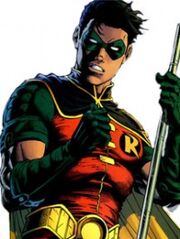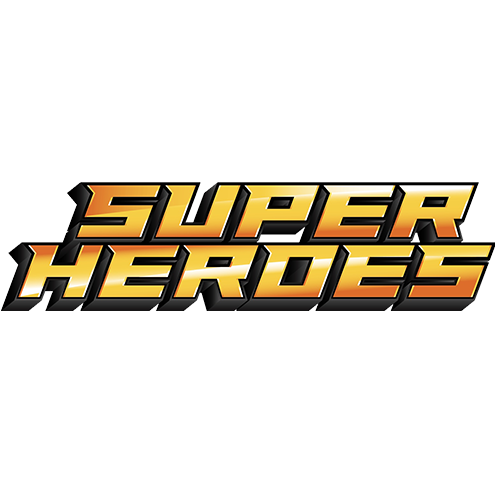No edit summary |
(→Mask) |
||
| Line 18: | Line 18: | ||
[[Image:200px-Robin2-1-.jpg | thumb | Robin's mask is a traditional example of a bar mask.]] |
[[Image:200px-Robin2-1-.jpg | thumb | Robin's mask is a traditional example of a bar mask.]] |
||
===Mask=== |
===Mask=== |
||
| − | A great number of super-heroes wear a |
+ | A great number of super-heroes wear a mask of some sort. This allows the hero in question to protect his identity while in public. Some heroes, hoever, may simply wear it for aesthetic reasons. Other common reasons include the idea that their mask has a connection to their super-power (such as [[The Mask|the Mask]]) and/or acts as armour ([[Iron Man]]). Still others may wear a mask due to shame of any deformities or scars they may have ([[The Thing]] wore a mask for a time after sustaining injuries from Wolverine). Common masks include full face masks that cover the whole head, domino masks held on with spirit gum, cowls that cover the upper part of the face, or bandanas that cover the mouth (The Shadow) or a cloth bandana like mask for the eyes (the [[Teenage Mutant Ninja Turtles]]). |
| + | |||
| + | Like the costume, the mask also usually follows a particular theme and in almost all cases works as part of the costume. |
||
===Teams=== |
===Teams=== |
||
Revision as of 13:30, 4 February 2014
A super-hero is a person with extraordinary skills or abilities who acts (or should act) out of respect for the greater good of all people. Super-heroes, in most cases, have dedicated themselves to help make the world a better place, usually by fighting villains or by averting some other disaster, often risking their lives to do so.
Traits of a Super-Hero
There are several traits that define a super-hero. Though not all super-heroes need the following, these things are often associated with super-heroes, including attitude, paraphenalia and capabilities
Costume
The costume is one of the most recognizable aspects of a super-hero, though not all super-heroes wear them. Costumes allow the hero to be instanfly recognized as a unique individual as most heroic costumes would not be confused with day to day wear. Costumes also often reflect the nature of the hero who wears it. Costumes may also, (usually when paired with a mask) provide anonymity for super-heroes who wish to protect their true identity. Though a smaller percentage of heroes wear them on the whole, capes are a very iconic element of the super-hero costume, thanks in no small part to the impact of early super-heroes such as Superman and Batman.
A super-hero's costume is most often (though certainly not always) a body suit that allows for maximum mobility and flexibility, as many participate in hand to hand fighting, or activities that need to allow as much freedom of movement as possible. This has caused some to joke that they are fighting in long underwear or in spandex (which is not uncommon). There are also many heroes who wear costumes that are alterations or variations on everyday clothes (jeans, coats, boots) and are usually custom made. Other "costumes" may function more as a suit of armor, to protect the wearer from damage. Heroes who worry about less about movement (magic practitioners, for example) may prefer something like flowing robes or something less common.
The suit often has an insignia or motif that matches the heroes name, ability or theme. It is common for super-heroes who are part of teams to wear a uniform to show their alliegence. Most costumes use bright, primary colours, with blue and red being the most commonly used colours. It is not uncommon for a hero to change his costumes, for any number of reasons. It could be that there's a new costume with more advanced technology, a sign of a personal change of some sort or simply a desire to were something different. In the case of more iconic heroes, it is usually a significant event if a hero changes his costume.
There are many costumes that in fact imbue their heroes with powers, or enhance them. In cases such as these, the wearer could not be a super-hero without them. Similarly, some super-heroes may magically transform into their costume. It is also common that many seemingly simply looking costumes hide gadgets and tools, or be more durable then their appearance. Often, a suit is designed for the powers of the individual (a person who controls flame has a fire proof suit) and can allow them to control their powers.
Though it is less common, there are super-heroes who don't wear costumes, usually those who are unconcerned with anonymity or making a statement. In other cases, it is simply because the character may not need clothes (such as a robot or an alien) or are wearing clothes that were not intended as a costume but became part of the character's "look".

Robin's mask is a traditional example of a bar mask.
Mask
A great number of super-heroes wear a mask of some sort. This allows the hero in question to protect his identity while in public. Some heroes, hoever, may simply wear it for aesthetic reasons. Other common reasons include the idea that their mask has a connection to their super-power (such as the Mask) and/or acts as armour (Iron Man). Still others may wear a mask due to shame of any deformities or scars they may have (The Thing wore a mask for a time after sustaining injuries from Wolverine). Common masks include full face masks that cover the whole head, domino masks held on with spirit gum, cowls that cover the upper part of the face, or bandanas that cover the mouth (The Shadow) or a cloth bandana like mask for the eyes (the Teenage Mutant Ninja Turtles).
Like the costume, the mask also usually follows a particular theme and in almost all cases works as part of the costume.
Teams
Many heroes form on teams that work together to help others. Although their identities are known to each other, the normal population does not know them.
Identity
Most heroes keep their identities secret. When a hero's identity is revealed, their enemies often track them and their loved ones to get them with their guard down. However, some superheroes do not have secret identities (like the Fantastic Four) while others who take little measure to hide them are still unknown.
Death
One of the most loved and hated cliches is the odd nature of death in super hero comics. Despite dying beyond possible healing, no character remains dead. Heroes are killed often, but writers tend to want to use old characters, causing in a resurrection of sorts. This can be either that the hero lived, they are brought back, a clone is made, the dead is an impostor, and other explanations.
Public View
For the most part, people in comics handle those with powers much better then the real world would. Almost all heroes in comics are loved by the public, however there are exceptions. In particular, the X-Men are known to be hated and feared by the general populace
